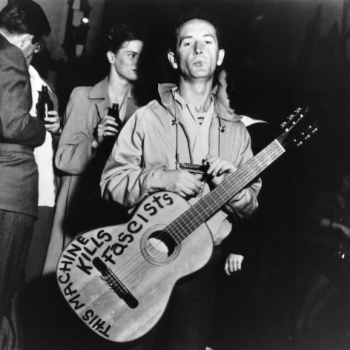Editors' Note: This article is part of the Patheos Public Square on Best Practices for Peace in 2015. Read other perspectives here.
In Buddhism, there is a beautiful articulation of mystical realization called peace. It is called One Taste. One Taste means that underneath it all, there is a unified field of awareness. This One Taste is not only eternal, it is eternity itself. It is unchanging radical presence that is both the ground and substance of All-That-Is.
What does One Taste feel like? What does it taste like? Christian mystic Thomas Aquinas reminds us, citing King David in the Psalms: "Taste and see that God is good." What does this good taste feel like? It feels like peace, stillness, bliss, ease, sweetness, elixir of honey, unconditional love, detachment, profound depth of calm, richly textured silence of presence. In the depth of I am awareness, all is exactly as it needs to be, and nothing could or should be any different than it is.
This is the good promised by most guides on the spiritual path. This is the intention of the Buddhist teaching that invites you to take refuge in the Buddha. These promises are real and true, however, they simply are not the whole story of peace. To teach them as the whole story is spiritual ignorance. Ignorance is not knowing nothing. Ignorance is not clueless; it is insightful, but only partially so. Ignorance is to take part of the story and make it into the whole.
Two Tastes
To experience peace you must paradoxically experience urgency. Let me explain. There is not One Taste but two, which are but two faces of the One. The Second Taste is not eternal and unchanging. Rather, it is dynamic and changing every moment. The Second Taste is not just peace, bliss, and quiet. It is wild, filled with cacophonies of sound, color, and texture, and makes the most beautiful, roaring, piercing music that you could ever imagine. It is not just silence; it is the eloquence and gorgeousness of great speech. It is not unconditional sweet loving, but passionate, stormy, and wild loving that makes uncompromising demands, even as it gives uncompromising gifts. A changeless reality that is absolute quiet and stillness—this is One Taste. Changing the world, the surge of emergence that begins with the big bang, makes loud and often raucous noise—this is the Second Taste that is grounded in, and moves beyond, the First Taste.
The First Taste
One accesses the First Taste through many of the classical forms of mystical meditation. One Taste is found through the realization of what early Buddhists called No-Self and later Buddhists called True Self. It is the taste of being. It is the place of Big Mind, the ground, the unchanging Tao, and atman. Through meditation, we access the unconditional love and peace principle of eternity. However, in this place, peace and love is not a quality of relationship but a quality of presence.
In the great traditions, this has been one face of ecstasy, the ecstatic release as one uncoils the egoic contraction and rests in Being. There is urgency in the desire to release. This is the human hunger for the Taste of Being. And there is ecstasy in the release itself. Many mystical paths are primarily focused on how to access and delight in the one Taste of Being.
All of this is good, true, beautiful—and it is also partial. It is fully half of the goal of the enlightenment path toward true peace.
The Second Taste
The Second Taste of peace is not that of Being but of Becoming. The principle at work here is not the eternal impulse but the evolutionary impulse. It is found through the realization of what some Sufi mystics have called personal essence. Speaking from my own realization, grounded in some Christian and many kabbalistic lineages, I have called it Unique Self.
After the evolution beyond ego and the identification with the impersonal, a new personal essence arises out of the very ground of the impersonal.
This is Unique Self. This Second Taste of peace is paradoxically dynamic, creative, and world-transforming. There is urgency to the Second Taste. The God-impulse of Second Taste is no less surging, ecstatic, and powerful than was the urge to merge in One Taste. In Second Taste, however, the ecstatic urgency is to emerge. This Second Taste ecstatic urgency aligns not with the eternal transcendent face of god, but with the evolutionary impulse of All-That-Is. The spiritual path that this ecstatic urge invites you to is the way of Becoming.
Meditation is generally thought to be a path to peace in the sense of being the path into pure Being. But meditation is also the path to paradoxical peace in the sense of becoming. Meditation accesses the surging life force that is the evolutionary dance of unfolding.
In particular, certain forms of tantric or kabbalistic meditation open the door to that ecstatic evolutionary impulse toward unfolding that lives uniquely in you, as you, and through you. It is the same impulse that utterly demands the creativity of the artist even as it moves the mother to ecstatically suffer the pain of childbirth.
True peace cannot rest merely in being. It must participate in the ecstatic urgency of becoming. The original Hebrew word for peace is Shalom. In the kabbalistic tradition, Shalom is the harmony of radical opposites, particularly the qualities of being and becoming, which must also dance together in order to attain Shalom, peace.
1/7/2015 5:00:00 AM




